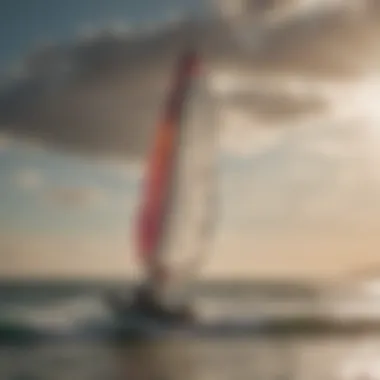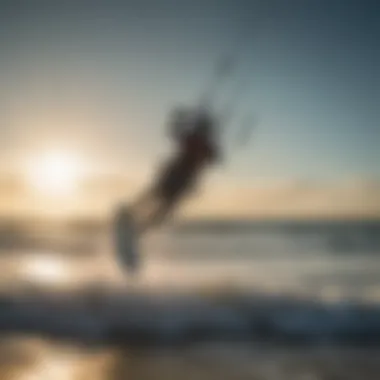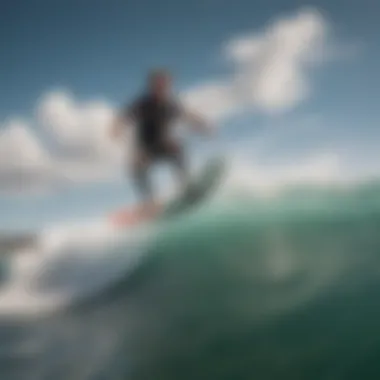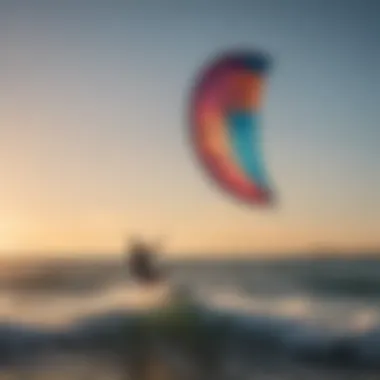Master the Art of Kite Sailing with Kitezy's Expert Lessons


Equipment Reviews
Are you ready to delve into the intricate world of kite sailing gear? Let's start by dissecting the latest cutting-edge kite models, examining their innovative features, and evaluating their performance in various wind conditions. It's essential to grasp the nuances of kite shapes, ranging from bow kites to delta kites, their sizes and how they impact stability, lift, and steering ability. We'll also delve into the materials used in kite construction, highlighting the advantages of ripstop nylon, Dacron, and other high-performance fabrics. Furthermore, we'll explore renowned kite brands like Cabrinha, North, and Slingshot, drawing comparisons on durability, responsiveness, and ease of use.
When it comes to kiteboarding boards, the array of options can be overwhelming. From versatile twintips suitable for freestyle tricks to directional boards optimized for wave riding, each design element significantly influences your riding style and performance. Let's evaluate the construction materials such as carbon, wood, and foam, discussing their impact on board weight, flex, and durability. Whether you're a beginner seeking stability or an advanced rider craving speed and control, understanding the nuances of board design is crucial for optimizing your kiteboarding experience.
No kite surfer should underestimate the importance of accessories – they are the unsung heroes that enhance your performance and safety on the water. Explore the role of essential items like harnesses, ensuring a secure connection between you and the kite for optimal control. Dive into the world of kiteboarding lines, varying in length and material composition, influencing power delivery and responsiveness. Discover the significance of pumps in inflating your kite quickly and effortlessly, allowing you to maximize your time on the water. Lastly, we'll emphasize the vital role of safety gear, including helmets, impact vests, and quick-release systems, essential for mitigating risks and ensuring a safe kitesurfing adventure.
Travel Destinations
Picture yourself gliding through the azure waters of the world's top kitesurfing destinations, where the wind whispers stories of exhilarating rides and breathtaking sceneries. Discover renowned spots like Maui, Tarifa, and Brazil, offering ideal wind conditions and crystal-clear waters for your kitesurfing pleasures. Uncover the local amenities, from cozy beachfront cafes to vibrant night markets, enriching your experience on and off the water. Immerse yourself in the diverse attractions, whether it's exploring ancient ruins, snorkeling with vibrant marine life, or simply savoring local culinary delights.
For the adventurous spirits seeking more secluded kiteboarding sanctuaries, off the beaten path destinations beckon with their untouched beauty and uncharted waters. Journey to hidden gems like Zanzibar, Rodrigues Island, and Vietnam's Phan Rang, where tranquility and serenity reign supreme. Delve into the unique experiences these destinations offer, from kite sessions against a backdrop of majestic cliffs to encounters with local cultures and traditions, providing a truly immersive kitesurfing escapade.
Techniques and Tutorials
Embarking on your kitesurfing journey, mastering fundamental techniques is paramount to your success and enjoyment on the water. Let's begin with beginner guides, offering comprehensive step-by-step tutorials on launching and landing your kite safely, mastering basic riding stances, and executing smooth turns with finesse. Understanding wind window dynamics, power zones, and edge control will be pivotal in laying a solid foundation for your kitesurfing prowess.
As you progress in your kitesurfing odyssey, advanced skills beckon, challenging you to test your limits and expand your aerial repertoire. Dive into detailed instructions on executing jumps and grabs with precision, perfecting technical maneuvers like backrolls and front rolls, and conquering the art of wave riding with style. Whether you're drawn to the adrenaline rush of freestyle tricks or the artistry of wave carving, honing these advanced skills will elevate your kitesurfing game to new heights.
Safety Guidelines
In the dynamic realm of kite sailing, safety should always remain a top priority, guiding every decision and action on the water. Weather conditions play a pivotal role in kitesurfing safety, influencing wind strength, gusts, and unpredictable weather patterns. Educate yourself on reading wind forecasts, understanding wind shifts, and recognizing telltale signs of changing weather, empowering you to make informed decisions and safeguarding your well-being.
Amidst the thrill of kitesurfing adventures, emergencies may arise, requiring swift and decisive responses to ensure your safety and that of others. Establishing clear emergency protocols, from self-rescue techniques to signaling for external assistance, will equip you with the necessary skills to navigate unforeseen mishaps efficiently. Additionally, regular equipment maintenance rituals are essential rituals to uphold, from checking lines and knots to inspecting safety systems and inflation valves, fostering a culture of safety and reliability in your kitesurfing endeavors.
Introduction to Kite Sailing
Kite sailing is a captivating water sport that combines the thrill of sailing with the power of the wind. In this article, we delve into the essential aspects of kite sailing, from understanding the basics to mastering advanced techniques. Whether you are a novice looking to start your kite sailing journey or an experienced rider aiming to enhance your skills, this guide will provide you with valuable insights and tips to navigate the world of kite sailing successfully.
Understanding the Basics
Importance of Wind Conditions
When it comes to kite sailing, wind conditions play a crucial role in determining the success and safety of your sailing experience. The wind not only propels your kite but also dictates your speed and maneuverability on the water. Understanding wind patterns and strengths is essential for harnessing the wind's power effectively. By analyzing wind conditions, you can optimize your sailing performance and ensure a thrilling yet secure adventure on the waves.
Essential Safety Measures


Prioritizing safety is paramount in kite sailing, making essential safety measures fundamental to a successful outing. From proper equipment checks to practicing emergency procedures, ensuring your safety and the safety of others is non-negotiable. Implementing safety protocols like wearing a helmet, using a safety leash, and communicating with fellow sailors can prevent accidents and uphold a secure kite sailing environment.
Kite Sailing Equipment
There are two primary components of kite sailing equipment that heavily influence your performance - kite types and sizes, and the harness and control bar. These pieces of gear are designed to enhance your control, stability, and comfort on the water, making them indispensable for every kite sailor.
Kite Types and Sizes
Selecting the appropriate kite type and size is crucial for optimizing your sailing experience. Different kite designs cater to varying wind conditions and riding styles, allowing you to choose a kite that suits your skill level and preferences. Understanding the characteristics of different kite types can significantly impact your overall performance and enjoyment while on the water.
Harness and Control Bar
The harness and control bar serve as your connection to the kite, enabling you to maneuver and steer with precision. A comfortable harness distributes the kite's pull across your body, reducing strain and enhancing control. The control bar, on the other hand, allows you to adjust the kite angle and power, granting you the flexibility to navigate smoothly through the water.
Choosing the Right Location
Selecting the ideal location for kite sailing is paramount to a rewarding and safe experience. Factors such as wind consistency, water conditions, and available space must be considered when choosing your sailing spot. By assessing these factors and selecting suitable terrains, you can optimize your practice sessions and enjoy a seamless kite sailing adventure.
Factors to Consider
Factors like wind strength and direction, water depth, and potential obstacles must be carefully evaluated before embarking on your kite sailing journey. These considerations ensure that you choose a location that aligns with your skill level and preferences, enabling you to make the most of your time on the water.
Ideal Terrains
From expansive beaches to sheltered bays, the ideal terrains for kite sailing offer a combination of challenging yet fulfilling conditions. Selecting terrains with consistent winds and ample space for launching and landing is essential for honing your skills and mastering various sailing techniques. By choosing ideal terrains, you set the stage for a successful and enjoyable kite sailing experience.
Preparing for Your Lesson
Physical Conditioning
In the realm of kite sailing, physical conditioning plays a paramount role in ensuring a successful and safe experience on the waters. To embark on this thrilling journey, one must understand the significance of adequately preparing the body for the challenges ahead. Physical conditioning not only enhances performance but also reduces the risk of injuries during the lesson. Optimal strength and endurance levels are fundamental for withstanding the demands of kite sailing, while flexibility is crucial for executing swift and precise maneuvers. This section delves into the specifics of physical preparation to equip enthusiasts with the necessary tools for a fulfilling kite sailing experience.
Strength and Endurance Training
Strength and endurance training form the core pillars of physical conditioning for kite sailing. By engaging in targeted exercises that build muscle strength and cardiovascular endurance, individuals can increase their stamina and resilience on the water. These training regimens focus on developing the muscle groups essential for maintaining control and balance while harnessing the power of the kite. Furthermore, endurance training aids in prolonging the duration of each session, allowing enthusiasts to fully immerse themselves in the sport. The unique advantage of strength and endurance training lies in its ability to boost overall performance and confidence, ensuring a rewarding kite sailing adventure.
Flexibility Exercises


Apart from strength and endurance, flexibility is a key component of physical conditioning for kite sailing. Flexibility exercises aim to enhance range of motion and joint mobility, enabling practitioners to execute dynamic movements with ease. Improved flexibility plays a vital role in preventing injuries and optimizing performance during intricate kite control maneuvers. The incorporation o, complex poses promotes muscle elasticity and agility, contributing to fluid transitions and responsive reactions on the water. Flexibility exercises offer the advantage of agility enhancement and injury prevention, enriching the kite sailing experience for enthusiasts seeking mastery and refinement.
Mastering Kite Sailing Techniques
In the vast ocean of kite sailing knowledge, mastering kite sailing techniques stands as a pivotal point. These techniques encapsulate the essence of control, precision, and finesse required to navigate the waves with confidence and expertise. A deep understanding of mastering kite sailing techniques is not just about skill acquisition but also about safety and enjoyment while harnessing the power of the wind to its full potential. By honing these techniques, enthusiasts can elevate their kite sailing experience to new heights, mastering the art of kitesurfing with proficiency.
Body Dragging
Practicing Directional Control
Exploring the intricacies of practicing directional control during body dragging sessions sheds light on the fundamental aspect of maneuvering the kite in the desired direction. This skill is integral in kite sailing as it enables riders to control the trajectory of their movement and harness the wind's power effectively. The key characteristic of practicing directional control lies in the finesse required to adjust the kite's position relative to the wind window, enhancing speed and maneuverability. The unique feature of this technique is its adaptability to variable wind conditions, making it a versatile and essential skill for kite surfers seeking mastery in this exhilarating sport.
Wind Window Awareness
Delving into wind window awareness unveils the profound importance of understanding the wind's dynamics and its impact on kite sailing maneuvers. This skill enhances a rider's ability to position the kite optimally within the wind window, capitalizing on different wind speeds for maximum propulsion. The key characteristic of wind window awareness lies in the strategic utilization of wind power to enhance speed and agility on the water. Its unique feature lies in its contribution to rider safety, as a heightened awareness of wind patterns reduces the risk of accidents and enhances overall performance in kite sailing.
Water Start
Board Positioning
Mastering the intricacies of board positioning during a water start is crucial for achieving a smooth and efficient launch into the kite sailing journey. This aspect focuses on maintaining balance and control while positioning the board correctly for lift-off. The key characteristic of board positioning lies in its direct influence on the rider's stability and ability to catch the wind efficiently. Its unique feature lies in the strategic alignment of the board with the kite's movement, optimizing propulsion and speed for a successful water start.
Balancing Techniques
Exploring the realm of balancing techniques unveils the importance of stability and equilibrium in maintaining control during kite sailing maneuvers. These techniques focus on leveraging body position and weight distribution to adapt to changing wind conditions and wave dynamics. The key characteristic of balancing techniques lies in their role in enhancing rider control and responsiveness on the water. The unique feature of these techniques lies in their versatility, allowing riders to adjust their balance dynamically to navigate challenging conditions and optimize performance in kite sailing.
Riding the Waves
Navigating Upwind and Downwind
Navigating upwind and downwind embodies the essence of strategic positioning and effective directional control in kite sailing. This aspect focuses on optimizing the angles of movement relative to the wind for efficient navigation against or with the wind's force. The key characteristic of navigating upwind and downwind lies in its impact on speed and efficiency while covering distances on the water. Its unique feature lies in the tactical decision-making process it involves, requiring riders to assess wind patterns and adjust their route to maximize performance and speed.
Turning Techniques
Exploring the art of turning techniques sheds light on the critical skill of maneuvering the kite to change direction seamlessly during a ride. These techniques focus on agility, coordination, and timing in executing smooth and controlled turns on the water. The key characteristic of turning techniques lies in their ability to facilitate fluid transitions between different directions, enhancing the rider's adaptability and responsiveness on the board. The unique feature of these techniques lies in their contribution to overall agility and maneuverability, allowing riders to navigate waves and obstacles with precision and finesse in kite sailing.
Ensuring Progress and Safety


Ensuring progress and safety in kite sailing is paramount for a successful and enjoyable experience. As kitesurfing and kiteboarding enthusiasts embark on their learning journey, refining skills is a cardinal aspect of advancement. Progress not only enhances performance but also ensures the safety of the rider and those around. It intertwines with the thrill of mastering complex maneuvers and controlling one's speed and direction on the water.
Refining Skills
Advanced Maneuvers
Discussing advanced maneuvers is crucial in the context of kite sailing lessons. Advanced maneuvers push boundaries and challenge riders to elevate their skills. These maneuvers require a high level of proficiency and are often characterized by intricate movements and quick decision-making. Emphasizing fluidity and precision, mastering advanced maneuvers contributes significantly to the overall progression in kite sailing. Riders can enhance their agility, speed, and mastery over their equipment through practicing advanced maneuvers.
Speed and Control
Speed and control are essential elements in kite sailing technique. Maintaining control at high speeds can be demanding but contributes significantly to the rider's ability to navigate different conditions effectively. Speed and control offer riders the opportunity to challenge themselves, improve their reaction time, and explore the thrill of acceleration on the water. Achieving a balance between speed and control is vital for a successful kite sailing experience, ensuring riders can maneuver with confidence and precision.
Weather Awareness
Reading Wind Patterns
Understanding and interpreting wind patterns is a fundamental aspect of kite sailing safety. Reading wind patterns enables riders to harness the wind's power effectively and navigate the water with agility. By recognizing wind shifts and gusts, riders can adjust their techniques and positioning to optimize their performance. Wind pattern reading is a skill that enhances a rider's adaptability and responsiveness to changing environmental conditions.
Avoiding Hazards
Prioritizing hazard avoidance is paramount in kite sailing. Identifying potential risks such as offshore winds, obstacles, or changing weather conditions is essential for a safe and enjoyable experience. By proactively recognizing and mitigating hazards, riders can minimize accidents and ensure a smooth sailing session. Avoiding hazards requires vigilance, awareness, and a proactive approach to safety on the water.
Continuous Learning
Seeking Feedback
Seeking feedback is a valuable activity for riders to improve their skills continuously. Feedback provides insights into areas of strength and areas needing improvement, enabling riders to refine their techniques and enhance their performance. By actively seeking feedback from instructors or peers, riders can accelerate their learning curve and strive for excellence in kite sailing.
Setting Goals
Setting goals is a cornerstone of progression in kite sailing lessons. Goals provide riders with direction and motivation to push their boundaries and strive for mastery. By setting specific, achievable goals, riders can track their progress, celebrate milestones, and stay motivated throughout their kite sailing journey. Setting goals encourages perseverance, dedication, and a growth mindset in pursuit of excellence.
Conclusion
Kite sailing is not merely a sport; it is a profound journey of self-discovery and mastery. Throughout this article, we have delved into the intricate details of preparing, mastering techniques, ensuring progress, and prioritizing safety in kite sailing. The conclusion encapsulates the essence of embracing the kite sailing journey, highlighting the transformative power of progress and community engagement. Celebrating progress plays a pivotal role in acknowledging achievements, fostering motivation, and instilling a sense of fulfillment in the kite sailing experience. By recognizing and celebrating milestones, individuals can stay motivated and track their growth, contributing to a more enriching and rewarding journey. On the other hand, community engagement acts as a cornerstone of support, learning, and camaraderie within the kite sailing community. It offers opportunities to connect with like-minded enthusiasts, share experiences, gather insights, and collectively propel the sport forward. Engaging with the community not only enhances skills and knowledge but also cultivates a sense of belonging and unity among enthusiasts, reinforcing the thrill and spirit of kite sailing.
Embracing the Kite Sailing Journey
Celebrating Progress
Delving into the realm of celebrating progress, we uncover a fundamental aspect of personal growth and achievement in kite sailing. The significance of celebrating progress lies in its ability to acknowledge small victories, milestones, and advancements, fostering a positive mindset and a sense of accomplishment. Recognizing progress serves as a powerful motivator, encouraging individuals to strive for continuous improvement and excellence in their kite sailing pursuits. By celebrating progress, participants can boost their confidence, reinforce their commitment to learning, and derive gratification from their evolving skills and expertise. This positive reinforcement not only enhances the learning experience but also propels individuals towards higher levels of proficiency and enjoyment in kite sailing.
Community Engagement
Community engagement stands as an integral element of the kite sailing journey, offering a myriad of benefits to enthusiasts and novices alike. The essence of community engagement lies in its capacity to create a support network, share knowledge, and foster a sense of camaraderie among kite sailing enthusiasts. By actively engaging with the community, individuals can tap into a vast pool of experiences, tips, and insights, accelerating their learning curve and expanding their understanding of the sport. Moreover, community engagement facilitates the exchange of ideas, best practices, and resources, creating a collaborative environment where individuals can learn, grow, and thrive together. The camaraderie forged through community engagement not only enhances skills and safety awareness but also fortifies the sense of belonging and unity within the kite sailing community, making the journey even more gratifying and fulfilling.







